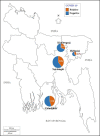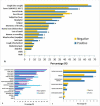Establishing a sentinel surveillance system for the novel COVID-19 in a resource-limited country: methods, system attributes and early findings
- PMID: 34857579
- PMCID: PMC8640197
- DOI: 10.1136/bmjopen-2021-055169
Establishing a sentinel surveillance system for the novel COVID-19 in a resource-limited country: methods, system attributes and early findings
Abstract
Objectives: To establish a hospital-based platform to explore the epidemiological and clinical characteristics of patients screened for COVID-19.
Design: Hospital-based surveillance.
Setting: This study was conducted in four selected hospitals in Bangladesh during 10 June-31 August 2020.
Participants: In total, 2345 patients of all age (68% male) attending the outpatient and inpatient departments of surveillance hospitals with any one or more of the following symptoms within last 7 days: fever, cough, sore throat and respiratory distress.
Outcome measures: The outcome measures were COVID-19 positivity and mortality rate among enrolled patients. Pearson's χ2 test was used to compare the categorical variables (sign/symptoms, comorbidities, admission status and COVID-19 test results). Regression analysis was performed to determine the association between potential risk factors and death.
Results: COVID-19 was detected among 922 (39%) enrolled patients. It was more common in outpatients with a peak positivity in second week of July (112, 54%). The median age of the confirmed COVID-19 cases was 38 years (IQR: 30-50), 654 (71%) were male and 83 (9%) were healthcare workers. Cough (615, 67%) was the most common symptom, followed by fever (493, 53%). Patients with diabetes were more likely to get COVID-19 than patients without diabetes (48% vs 38%; OR: 1.5; 95% CI: 1.2 to 1.9). The death rate among COVID-19 positive was 2.3%, n=21. Death was associated with age ≥60 years (adjusted OR (AOR): 13.9; 95% CI: 5.5 to 34), shortness of breath (AOR: 9.7; 95% CI: 3.0 to 30), comorbidity (AOR: 4.8; 95% CI: 1.1 to 21.7), smoking history (AOR: 2.2, 95% CI: 0.7 to 7.1), attending the hospital in <2 days of symptom onset due to critical illness (AOR: 4.7; 95% CI: 1.2 to 17.8) and hospital admission (AOR: 3.4; 95% CI: 1.2 to 9.8).
Conclusions: COVID-19 positivity was observed in more than one-third of patients with suspected COVID-19 attending selected hospitals. While managing such patients, the risk factors identified for higher death rates should be considered.
Keywords: COVID-19; diagnostic microbiology; epidemiology; public health.
© Author(s) (or their employer(s)) 2021. Re-use permitted under CC BY-NC. No commercial re-use. See rights and permissions. Published by BMJ.
Conflict of interest statement
Competing interests: None declared.
Figures



Similar articles
-
Characteristics and outcomes of patients with COVID-19 admitted to hospital and intensive care in the first phase of the pandemic in Canada: a national cohort study.CMAJ Open. 2021 Mar 8;9(1):E181-E188. doi: 10.9778/cmajo.20200250. Print 2021 Jan-Mar. CMAJ Open. 2021. PMID: 33688026 Free PMC article.
-
Implementation of a COVID-19 surveillance programme for healthcare workers in a teaching hospital in an upper-middle-income country.PLoS One. 2021 Apr 14;16(4):e0249394. doi: 10.1371/journal.pone.0249394. eCollection 2021. PLoS One. 2021. PMID: 33852588 Free PMC article.
-
Risk Factors Associated With In-Hospital Mortality in a US National Sample of Patients With COVID-19.JAMA Netw Open. 2020 Dec 1;3(12):e2029058. doi: 10.1001/jamanetworkopen.2020.29058. JAMA Netw Open. 2020. PMID: 33301018 Free PMC article.
-
Patient characteristics associated with COVID-19 positivity and fatality in Nigeria: retrospective cohort study.BMJ Open. 2020 Dec 17;10(12):e044079. doi: 10.1136/bmjopen-2020-044079. BMJ Open. 2020. PMID: 33334842 Free PMC article.
-
Comparison of characteristics, predictors and outcomes between the first and second COVID-19 waves in a tertiary care centre in Switzerland: an observational analysis.Swiss Med Wkly. 2021 Aug 10;151:w20569. doi: 10.4414/smw.2021.20569. eCollection 2021 Aug 2. Swiss Med Wkly. 2021. PMID: 34375985
Cited by
-
Estimating the incidence of COVID-19, influenza and respiratory syncytial virus infection in three regions of Queensland, Australia, winter 2022: findings from a novel longitudinal testing-based sentinel surveillance programme.BMJ Open. 2024 Apr 22;14(4):e081793. doi: 10.1136/bmjopen-2023-081793. BMJ Open. 2024. PMID: 38653507 Free PMC article.
-
Sero-prevalence and risk factors for Severe Acute Respiratory Syndrome Coronavirus 2 infection in women and children in a rural district of Bangladesh: A cohort study.J Glob Health. 2022 Jul 23;12:05030. doi: 10.7189/jogh.12.05030. J Glob Health. 2022. PMID: 35866222 Free PMC article.
-
Evaluation of wastewater percent positive for assessing epidemic trends - A case study of COVID-19 in Shangrao, China.Infect Dis Model. 2024 Nov 16;10(1):325-337. doi: 10.1016/j.idm.2024.11.001. eCollection 2025 Mar. Infect Dis Model. 2024. PMID: 39649243 Free PMC article.
References
-
- Worldometer . Coronavirus update (live): cases and deaths from COVID-19 virus pandemic. Available: https://www.worldometers.info/coronavirus/ [Accessed 1 Apr 2021].
Publication types
MeSH terms
LinkOut - more resources
Full Text Sources
Medical
